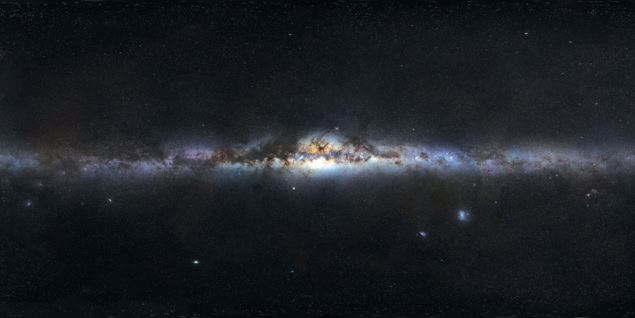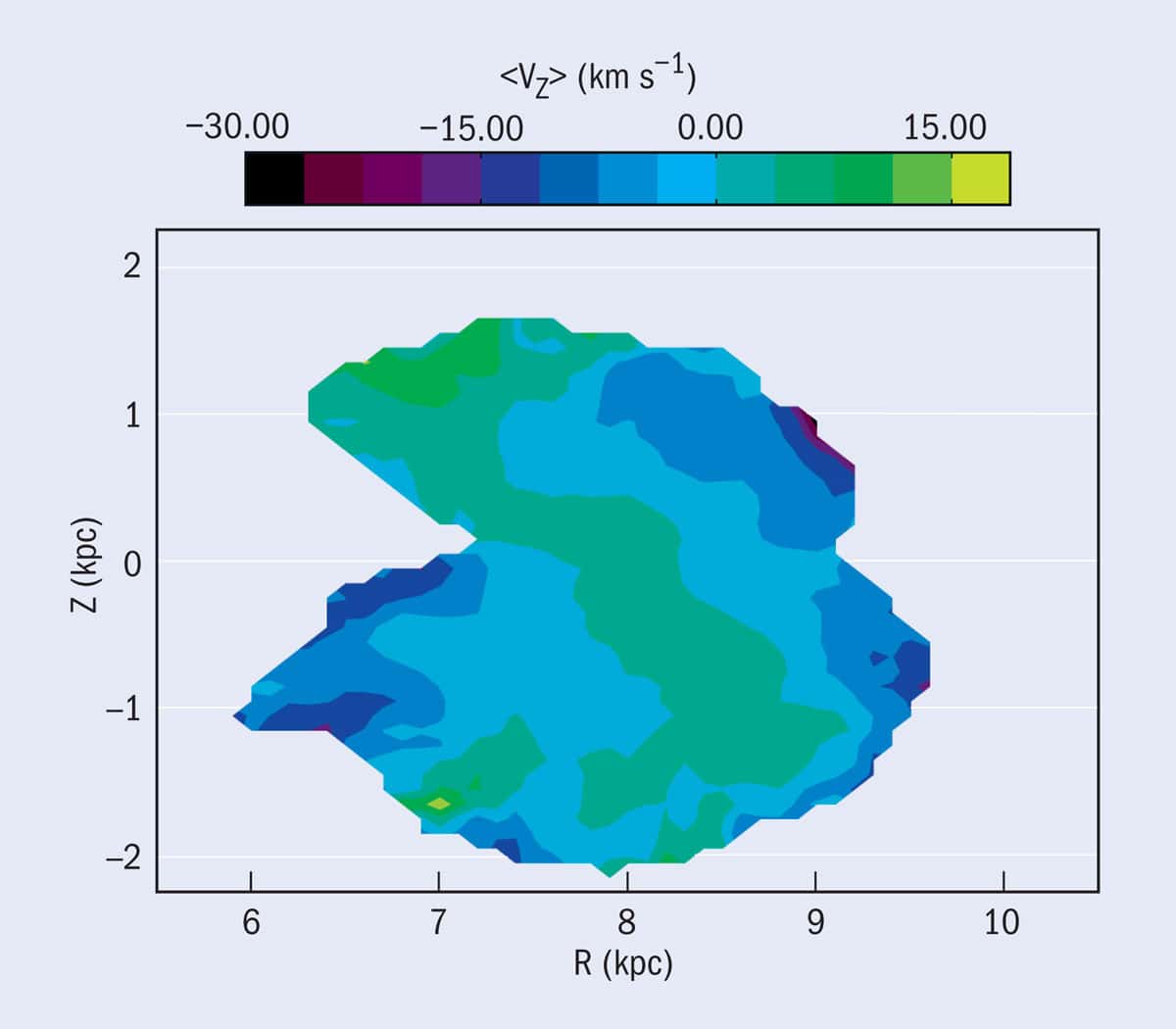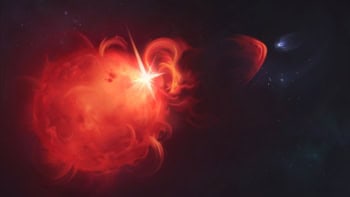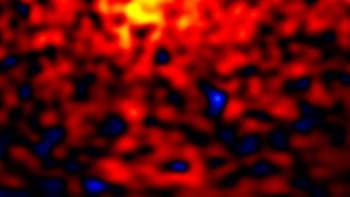It is well known that the Milky Way rotates around a supermassive black hole, but researchers have found that our galaxy undulates up and down as well like a giant galactic merry-go-round. Katia Moskvitch reports on this surprising finding

Black, heavy and calm, outer space seems motionless. Faraway stars flicker from time to time, as if lazily transmitting some cosmic Morse code. And on a clear night, the Milky Way looks as if it is painted on a huge, glossy black dome; the stars seem motionless, pinned into place.
Of course, we know that our home galaxy is not as still as it appears – its entire disc rotates horizontally about its centre. But in a surprising twist, recent observations by three independent teams of astronomers suggest that the Milky Way also undulates up and down. Thousands of stars in it constantly wobble vertically at speeds of about 20–30 km/s, stirring the galactic milkshake of stars and gas.
Just like any other spiral galaxy, the Milky Way looks like a pinwheel – a flat disc with spiral “arms” full of some 200–400 billion stars and a supermassive black hole at its centre. The motion of the Sun with respect to other nearby stars has been known for centuries, but it was in 1927 that Bertil Lindblad and Jan Oort came up with the first detailed model of our galaxy’s motion, including its rotation.
We now know that individual stars orbit around the centre, making the whole disc rotate at about 220 km/s at the Sun’s distance from the galactic centre. Also known is the random vertical motion of stars, much like a gas. But the bulk vertical up-and-down motion came as a surprise that no-one can yet explain. Perhaps the Milky Way is bumping into chunks of dark matter, or maybe some past collisions with other galaxies set it off ringing like a bell, suggests Mary Williams from the Leibniz Institute for Astrophysics Potsdam in Germany.
Williams leads one of the three groups to have suggested the Milky Way’s peculiar vertical motion. Together with colleagues, she examined the movement of nearly half a million stars in a 3D volume around the Sun, using data gathered by the Radial Velocity Experiment (RAVE). A collaboration of researchers from more than 20 institutes around the world, RAVE ran for 10 years until April 2013 using data from the UK Schmidt Telescope of the Australian Astronomical Observatory.
The telescope measured starlight at infrared wavelengths between 840 and 880 nm. Using the resulting spectra, the researchers derived the stars’ radial velocities, temperatures, elemental compositions and surface gravities (the latter being inversely proportional to the square of a star’s radius). Based on the temperatures and surface gravities, the team isolated a group of about 70,000 stars with roughly the same intrinsic brightness, dubbed “the red clump”.
As the stars in the red clump have the same brightness, the team estimated their distances from Earth by measuring how dim they are, much as a 60 W light bulb looks fainter when far away than close up. With this information, combined with the stars’ radial velocities and extra information from other stellar surveys giving the transverse movement of the stars across the sky, the researchers put together a map showing the full 3D motion of the stars in space. (Figure 1 shows the vertical component.)
The result was unexpected. Not only do the stars rotate, they also move in-and-out and up-and-down in the galaxy. “These motions are suggestive of a wave, much like a sound wave,” says Williams, whose work was published in October last year (Mon. Not. R. Astron. Soc. 436 101).
Moreover, the stars do not all appear to be moving in the same fashion, either. Stars that are closer to the centre of the galaxy than the Sun tend to drift away from the galactic plane, which goes through the middle of the galaxy’s disc. However, stars that lie further out than the Sun move in towards the plane. The overall result is that stars move up and down depending on their distance.
“Our result has shown that the galaxy is all squishy and wobbly – it’s not just spinning,” says Williams, who also likens the stars’ motion to dancers jumping up and down in the rotating “mosh pit” that sometimes forms in front of a stage at a rock concert. Reaching a definite conclusion was not easy, though, she adds. The results are incredibly complex, and you can only really see the vertical waves clearly on a 3D map.
1 Throwing a wobbly

Based on data from the Radial Velocity Experiment (RAVE) – a survey of almost half a million stars around the Sun – astronomers have found that the Milky Way not only rotates horizontally but also that individual stars move vertically up and down perpendicular to the plane of our galaxy. Shown here is a slice of the Milky Way cut along a radial line of the galactic disc, showing stars in the region near our Sun. Axes are coordinates, where R is the radial distance from the centre of the galaxy and Z is the distance above (Z > 0) or below (Z < 0) the plane. The Sun is located at (8.33,0.03). All distances are measured in kiloparsecs (kpc, where 1 kpc is roughly 3300 light-years). Colour indicates the stars’ average velocity in the Z direction, <vZ>, and reveals a ridge inclined at 40° to the R axis where stars move upwards (green), whereas either side they move downwards (blue). The differences in stellar speeds resemble velocity maps for sound waves, supporting the theory that vertical waves exist in the galaxy.
Ripples of excitement
Just months before Williams and colleagues published their work, another team announced similar results. Led by astrophysicist Larry Widrow of Queen’s University in Kingston, Canada, the team analysed data taken by the Sloan Digital Sky Survey (SDSS) of about 300,000 stars in the Milky Way. Widrow’s team found a small but statistically important difference in the distribution of the number of stars – as well as their motions – above and below the galactic plane. It was, Widrow says, as if there were “localized ripples going through the disc”.
One possible explanation for the ripples, according to Widrow, is based on there literally being more to the Milky Way than meets the eye. We know that it has a bright central bulge packed with stars, a flat rotating disc of stars, and a spherical halo of sparsely distributed stars that extends far beyond the galactic disc and contains more than 20 small satellite galaxies gobbled up by our own. But astronomers also believe that the Milky Way is surrounded by a halo of dark matter – an invisible substance of as-yet-unexplained composition that is thought to make up about 85% of all matter in our universe. According to computer simulations, dark matter can form massive lumps, which could have passed through our home galaxy’s disc, churning things up and generating vertical waves in the motion of stars, says Widrow.
Dark matter can form massive lumps, which could have passed through our home galaxy’s disc, churning things up
Williams’ research confirmed Widrow’s initial results with a larger data set, covering a larger region of the solar neighbourhood, extending roughly a quarter of the way to the centre of the Milky Way and about the same distance outward. The vertical flutter has also been confirmed by a third survey carried out by astrophysicists from the Rensselaer Polytechnic Institute in Troy, New York.
Published shortly after that of Williams, this third survey was based on observations made by the Chinese Large Sky Area Multi-Object Fiber Spectroscopic Telescope (LAMOST), located north-east of Beijing. “Although we were looking at a different part of the galaxy, we saw similar ‘wobbly’ patterns,” says Heidi Newberg, who took part in the research. Given that three different surveys are all showing the same thing, Williams feels the results are incredibly exciting, giving her “a lot of confidence that what we are seeing is real”.
A new wave of data
The next step is to use calculations and computer simulations to test different ideas about what makes the Milky Way flutter. Indeed, a new space craft will soon start bringing in a lot more observational results. The European Space Agency’s Gaia satellite, which took off successfully late last year, is expected to produce a wealth of data on the structure of the Milky Way. It will measure accurate distances to about a billion stars, and give their proper motions and radial velocities.
This information will help scientists to carefully map out the bulk motions seen in the SDSS, RAVE and LAMOST surveys in far greater detail and over a larger region of our galaxy, providing in turn a much better idea about the structure of the Milky Way’s galactic disc and the system of satellite galaxies and dark matter around it. “The final word will come with Gaia’s [measurements] for a staggering amount of stars,” says Williams. “With these we’ll be able to accurately trace the motions of stars in this region and way beyond, and the vertical waves we’re seeing [will be] starkly defined.”
The results could give us a better understanding of how galaxies form, and help refine existing models of the Milky Way, which assume that our galaxy is in equilibrium. And if it turns out that dark matter is stirring things up, the wobbles could help determine whether unseen “dark” dwarf galaxies are orbiting the Milky Way, says Newberg.
All things considered, our galaxy seems to be much more than a plain old rotating spiral.



